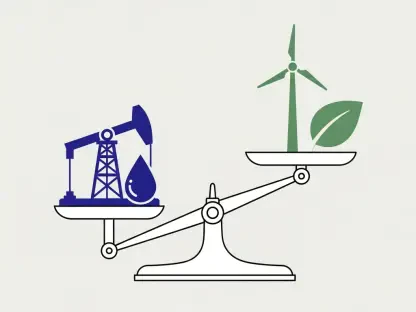Uzbekistan is spearheading an impressive shift towards renewable energy in Central Asia, with significant strides made in harnessing solar and wind power. The nation’s recent developments in renewable energy production have set benchmarks that are inspiring its regional neighbors. Over the past year, the renewable energy sector in Uzbekistan has made noteworthy advancements, reflected in both the volume of energy produced and the associated environmental benefits. The government’s strategic initiatives and ambitious goals signify a committed drive towards a greener, more sustainable future.
Uzbekistan’s Impressive Renewable Energy Achievements
As of October 20, 2023, Uzbekistan’s solar and wind power plants have collectively generated a remarkable 4 billion kilowatt-hours (kWh) of electricity. This total comprises approximately 3.5 billion kWh from solar power and 506.4 million kWh from wind farms. These figures not only highlight the country’s steadfast commitment to diversifying its energy portfolio but also underscore the significant progress Uzbekistan has made in reducing its reliance on traditional, carbon-intensive energy sources.
The environmental benefits of Uzbekistan’s move toward renewable energy are substantial. By transitioning to greener energy sources, the country has saved an estimated 1.2 billion cubic meters of natural gas and prevented 1.6 million tons of harmful emissions from being released into the atmosphere. These efforts have significantly mitigated environmental impact, setting a positive example for other nations in the region to follow. Uzbekistan’s progress demonstrates the tangible and far-reaching benefits of investing in renewable energy infrastructure.
Meeting Household Energy Needs
The renewable energy produced in Uzbekistan this year is sufficient to supply the 10-month electricity requirements of 2 million households, or alternatively, it could fulfill the annual energy needs of 1.6 million households. This practical application of green energy showcases its potential to meet substantial domestic energy demands effectively. The ability to power millions of homes with clean energy reflects the practical benefits of Uzbekistan’s renewable energy initiatives beyond environmental considerations.
The government’s proactive measures to purchase electricity from the population further illustrate its commitment to integrating renewable sources at all levels of the energy sector. In the first two months of 2023 alone, authorities acquired electricity worth 500 million sums from local consumers. This approach fosters a collaborative environment where the public can actively participate in and benefit from the nation’s renewable energy growth. Such initiatives not only support energy security but also stimulate the local economy by encouraging investments in personal renewable energy installations.
Strategic Vision for the Future
Uzbekistan’s government has outlined an ambitious vision for the future of its energy sector, aiming to significantly increase the share of renewable energy. By 2030, the country plans to elevate the portion of renewable energy in its total energy production to 40%. Currently, renewable energy—primarily derived from solar and wind power—constitutes nearly 10% of Uzbekistan’s national energy mix. These ambitious goals require meticulous planning and substantial investment in renewable infrastructure.
Projections indicate that the share of renewable energy will rise to 15% by the end of 2024, with an expected increase in green energy production to 13 billion kWh. This strategic planning underscores the government’s foresight and dedication to creating a sustainable energy future. President Shavkat Mirziyoyev has acknowledged the vast potential of wind energy in Uzbekistan, noting that the country’s wind capacities could exceed its electricity needs by 10 to 12 times. This recognition suggests a significant untapped resource that could propel Uzbekistan toward energy self-sufficiency.
Potential in Neighboring Tajikistan
While Uzbekistan leads the renewable energy charge in Central Asia, neighboring Tajikistan also holds considerable potential, particularly in solar energy. Located within the “golden belt” of sunshine, Tajikistan benefits from 2,100 to 3,166 hours of annual sunshine, equivalent to about 260 to 300 sunny days each year. This geographical advantage makes solar energy an attractive and viable alternative energy source for the country.
Despite this significant solar potential—estimated at around 25 billion kWh per year—solar energy currently contributes less than 1% to Tajikistan’s energy mix. This discrepancy highlights a considerable opportunity for growth and development within the solar sector. The underutilization of solar resources indicates that with the right investments and policy frameworks, Tajikistan could significantly boost its solar energy capacity and reduce its reliance on traditional energy sources.
Wind Energy Prospects in Tajikistan
Similarly, the wind energy potential in Tajikistan presents another promising avenue for renewable energy development. Estimates suggest that the annual potential for wind energy production ranges between 30 billion and 100 billion kWh. This capacity could rival the output of several existing hydropower plants, offering a sustainable and renewable alternative to bolster the country’s energy mix.
However, realizing this potential will require significant investment and infrastructural development. By following the example set by Uzbekistan, Tajikistan could rapidly advance its renewable energy aspirations. The focus on wind energy could complement its existing energy portfolio, contributing to a more balanced and sustainable energy infrastructure. Continued investment in renewable technologies and infrastructure will be crucial in enabling Tajikistan to harness its wind energy potential fully.
Central Asia’s Collective Renewable Energy Movement
Uzbekistan is leading the charge in Central Asia’s renewable energy revolution, making significant progress in solar and wind energy. This nation has recently set impressive new benchmarks in renewable energy production, serving as a model for its neighboring countries. Over the past year, Uzbekistan has seen notable achievements in the renewable sector, evidenced by the increased volume of energy generated and the substantial environmental benefits that accompany this growth.
The country’s government has demonstrated a clear commitment to a sustainable future by implementing strategic initiatives and setting ambitious goals. The focus on renewable energy isn’t just a fleeting trend but a substantial part of Uzbekistan’s long-term vision for a greener tomorrow. These efforts are not only aimed at reducing carbon footprints but also at ensuring energy security and independence. By investing in cutting-edge technologies and infrastructure, Uzbekistan aims to become a regional leader in clean energy, thus promoting a more eco-friendly and sustainable development path for the entire Central Asian region.









